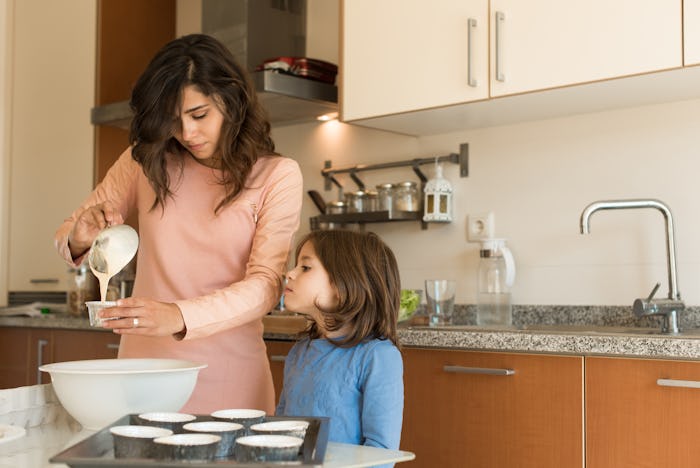Life

Stay-At-Home Moms Are Doing Better Than All Of Us In Quarantine
When schools and daycares closed due to the COVID-19 pandemic, the world divided into two camps, or so it felt to many parents: those with small children at home and those rewatching Mad Men. What parents are being asked to do in quarantine is not only unprecedented, it can feel impossible. Suddenly parents (read: moms, mostly — more on that below) are responsible for leading all of their children’s learning and activities, in addition to the planning and organization, parenting, and household responsibilities they were already carrying. If you don’t live with extended family who help out, childcare has evaporated. It’s just you and your kid(s) all day, every day.
In “Motherhood in the Age of COVID-19," a new survey Romper conducted in partnership with The Clinton Foundation’s early learning initiative, Too Small to Fail, Romper spoke to 2000 moms across the country, all with kids between the ages of 0 and 12, about what life in quarantine has been like for them. We talked to moms from a range of backgrounds, family structures, employment statuses about how they are doing, their biggest sources of worry and stress, and what resources and strategies they have found useful.
Stay-at-home moms were the least likely of all moms we surveyed to have disagreed with their partners about the division of labor in their home.
One thing we asked all 2000 mothers was whether balancing work and home responsibilities has gotten harder since they’ve been home with their kids. The most striking finding was that 57 percent of stay-at-home moms with kids ages 0-12 said it hasn’t. (Moms newly working from home due to COVID-19 were the most likely to say that it absolutely has. Essential workers still going to work were in the middle.) Among stay-at-home moms of younger children ages 0-3, that number went up to 63%.
There are lots of potential reasons for this. Stay-at-home moms are used to spending a LOT of time with their children. They have had years to stockpile absorbing activities that will engage their children when they need to make a phone call or try to do a few planks for once in their lives. Stay-at-home moms are more likely to have a traditional division of labor in their relationships, wherein they handle everything domestic, and their partner supplies the family income. While being an elementary or preschool teacher in addition to everything else was probably not in their five-year plan, they do not have the unforeseen hell of helping collect items that begin with the letter L while Zooming with a client.
Responsibility, fortitude, perseverance, resilience: motherhood asks this of all of us, but stay-at-home moms are asked for it every hour of every day.
That doesn’t mean being a stay-at-home mom is easy, by a long shot. Everyone who use to go to an office for eight hours a day but now spends those hours with a toddler has learned this recently, if they didn’t know it before. On top of that, stay-at-home moms’ domestic load tends to increase over the years. As Eve Brodsky details in Fair Play, her informed and practical book on this very issue, many gradually see their partner’s personal errands shift over to their plates, in addition to all home, kid, and school tasks, car maintenance, caring for the family pet(s), insurance claims, thank you notes, figuring out why the wifi is weak… and on and on. There are hours in the car, if you can ever get the kids out of the house. There is relatively little adult interaction that does not revolve around children.
Since COVID-19 showed up, SAHMs have taken on even more. Fifteen percent say they are trying to do more educational activities with their kids in addition to their children’s remote learning. Fifty-four percent are spending over an hour more each day planning their children's activities than they already were, and 21% are spending 2+ more hours daily plotting how to engage their kids. They also told us that it's harder to clean the house with small people crisscrossing it. Yet stay-at-home moms were the least likely of all moms we surveyed to have disagreed with their partners about the division of labor in their home.
Again, there are obvious possible reasons for this. If a woman is partnered and the division of labor is very clear and the mother is OK with it, taking on more domestic tasks in quarantine may not violate that agreed-upon division. Also, there are simply bigger worries right now. Those whose partners are working from home may have the specter of a potential layoff looming over them at all times. For those whose partners are essential workers still going out to work, there is concern that partners will bring home the virus and sicken whole families. When partners are out of work, there is financial peril. If you’re thinking about any of the above, you may be less annoyed about the other person forgetting to take out the trash.
But this lack of griping also jibes with the general perspective stay-at-home moms have to take, that they will get everyone fed and in bed no matter what the day brings, because there is no other option. Responsibility, fortitude, perseverance, resilience: motherhood asks this of all of us, but stay-at-home moms are asked for it every hour of every day. No wonder a pandemic is no match for them.